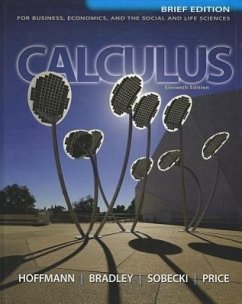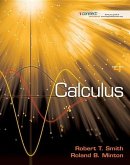Laurence D Hoffmann, Gerald L Bradley, David Sobecki, Michael Price
Calculus for Business, Economics, and the Social and Life Sciences, Brief Version, Media Update
Laurence D Hoffmann, Gerald L Bradley, David Sobecki, Michael Price
Calculus for Business, Economics, and the Social and Life Sciences, Brief Version, Media Update
- Gebundenes Buch
- Merkliste
- Auf die Merkliste
- Bewerten Bewerten
- Teilen
- Produkt teilen
- Produkterinnerung
- Produkterinnerung
Calculus for Business, Economics, and the Social and Life Sciences, Brief Edition provides a sound, intuitive understanding of the basic concepts students need as they pursue careers in business, economics, and the life and social sciences. Students achieve success using this text as a result of the author's applied and real-world orientation to concepts, problem-solving approach, straight forward and concise writing style, and comprehensive exercise sets. More than 100,000 students worldwide have studied from this text!
Andere Kunden interessierten sich auch für
![Applied Calculus for Business, Economics, and the Social and Life Sciences, Expanded Edition, Media Update Applied Calculus for Business, Economics, and the Social and Life Sciences, Expanded Edition, Media Update]() Laurence D HoffmannApplied Calculus for Business, Economics, and the Social and Life Sciences, Expanded Edition, Media Update279,99 €
Laurence D HoffmannApplied Calculus for Business, Economics, and the Social and Life Sciences, Expanded Edition, Media Update279,99 €![Loose Leaf Version for Calculus for Business, Economics, and the Social and Life Sciences, Brief Loose Leaf Version for Calculus for Business, Economics, and the Social and Life Sciences, Brief]() Laurence D HoffmannLoose Leaf Version for Calculus for Business, Economics, and the Social and Life Sciences, Brief216,99 €
Laurence D HoffmannLoose Leaf Version for Calculus for Business, Economics, and the Social and Life Sciences, Brief216,99 €![Calculus for Life Sciences, 1e Student Solutions Manual Calculus for Life Sciences, 1e Student Solutions Manual]() Sebastian J SchreiberCalculus for Life Sciences, 1e Student Solutions Manual76,99 €
Sebastian J SchreiberCalculus for Life Sciences, 1e Student Solutions Manual76,99 €![Calculus for the Management, Life and Social Sciences Calculus for the Management, Life and Social Sciences]() Bernard KolmanCalculus for the Management, Life and Social Sciences130,99 €
Bernard KolmanCalculus for the Management, Life and Social Sciences130,99 €![Modeling the Dynamics of Life: Calculus and Probability for Life Scientists Modeling the Dynamics of Life: Calculus and Probability for Life Scientists]() Frederick R. AdlerModeling the Dynamics of Life: Calculus and Probability for Life Scientists437,99 €
Frederick R. AdlerModeling the Dynamics of Life: Calculus and Probability for Life Scientists437,99 €![Calculus for the Life Sciences Calculus for the Life Sciences]() Sebastian J SchreiberCalculus for the Life Sciences171,99 €
Sebastian J SchreiberCalculus for the Life Sciences171,99 €![Calculus Calculus]() Robert T SmithCalculus283,99 €
Robert T SmithCalculus283,99 €-
-
-
Calculus for Business, Economics, and the Social and Life Sciences, Brief Edition provides a sound, intuitive understanding of the basic concepts students need as they pursue careers in business, economics, and the life and social sciences. Students achieve success using this text as a result of the author's applied and real-world orientation to concepts, problem-solving approach, straight forward and concise writing style, and comprehensive exercise sets. More than 100,000 students worldwide have studied from this text!
Hinweis: Dieser Artikel kann nur an eine deutsche Lieferadresse ausgeliefert werden.
Hinweis: Dieser Artikel kann nur an eine deutsche Lieferadresse ausgeliefert werden.
Produktdetails
- Produktdetails
- Verlag: McGraw Hill LLC
- 11th Brief edition
- Seitenzahl: 1600
- Erscheinungstermin: 10. Januar 2012
- Englisch
- Abmessung: 257mm x 211mm x 30mm
- Gewicht: 1610g
- ISBN-13: 9780073532387
- ISBN-10: 007353238X
- Artikelnr.: 34919978
- Herstellerkennzeichnung
- Libri GmbH
- Europaallee 1
- 36244 Bad Hersfeld
- 06621 890
- Verlag: McGraw Hill LLC
- 11th Brief edition
- Seitenzahl: 1600
- Erscheinungstermin: 10. Januar 2012
- Englisch
- Abmessung: 257mm x 211mm x 30mm
- Gewicht: 1610g
- ISBN-13: 9780073532387
- ISBN-10: 007353238X
- Artikelnr.: 34919978
- Herstellerkennzeichnung
- Libri GmbH
- Europaallee 1
- 36244 Bad Hersfeld
- 06621 890
Laurence D. Hoffmann November 2011 I consider myself to be a writer and expositor as well as a mathematician, and these traits led to the original version of this text published in 1975. Before assuming my current position as a Senior Investment Management Consultant with Morgan Stanley Smith Barney, I was a tenured professor of mathematics at Claremont McKenna College, where, on three occasions, I was honored to be the recipient of the Huntoon Award for Excellence in Teaching, a "best-teacher" award determined by a vote of the students. In addition to my current profession and my ongoing involvement with this text, I serve on the Strategic Planning committee of the Claremont Community foundation and on the Investment Committee of the Rancho Santa Ana Botanic Gardens in Claremont. My wife, Janice, and I love to travel, enjoy music and the arts, have two grown sons, three grandchildren and two Maltese dogs. I am an avid (but average) tennis player, am addicted to the Sunday Puzzle on NPR, and have been trying for several years to become fluent in Italian. Long ago, I received by BA in mathematics from Brown University and my Ph.D. in mathematics from the University of Wisconsin.
Chapter 1: Functions, Graphs, and Limits
1.1Functions
1.2The Graph of a Function
1.3Lines and Linear Functions
1.4Functional Models
1.5Limits
1.6One-Sided Limits and Continuity
Chapter 2: Differentiation: Basic Concepts
2.1The Derivative
2.2Techniques of Differentiation
2.3Product and Quotient Rules; Higher-Order Derivatives
2.4The Chain Rule
2.5Marginal Analysis and Approximations Using Increments
2.6Implicit Differentiation and Related Rates
Chapter 3: Additional Applications of the Derivative
3.1 Increasing and Decreasing Functions; Relative Extrema
3.2 Concavity and Points of Inflection
3.3 Curve Sketching
3.4 Optimization; Elasticity of Demand
3.5 Additional Applied Optimization
Chapter 4: Exponential and Logarithmic Functions
4.1 Exponential Functions; Continuous Compounding
4.2 Logarithmic Functions
4.3 Differentiation of Exponential and Logarithmic Functions
4.4 Additional Applications; Exponential Models
Chapter 5: Integration
5.1 Indefinite Integration and Differential Equations
5.2 Integration by Substitution
5.3 The Definite Integral and the Fundamental Theorem of Calculus
5.4 Applying Definite Integration: Distribution of Wealth and Average Value
5.5 Additional Applications to Business and Economics
5.6 Additional Applications to the Life and Social Sciences
Chapter 6: Additional Topics in Integration
6.1 Integration by Parts; Integral Tables
6.2 Numerical Integration
6.3 Improper Integrals
6.4 Introduction to Continuous Probability
Chapter 7: Calculus of Several Variables
7.1 Functions of Several Variables
7.2 Partial Derivatives
7.3 Optimizing Functions of Two Variables
7.4 The Method of Least-Squares
7.5 Constrained Optimization: The Method of Lagrange Multipliers
7.6 Double Integrals
Appendix A: Algebra Review
A.1 A Brief Review of Algebra
A.2 Factoring Polynomials and Solving Systems of Equations
A.3 Evaluating Limits with L'Hopital's Rule
A.4 The Summation Notation
1.1Functions
1.2The Graph of a Function
1.3Lines and Linear Functions
1.4Functional Models
1.5Limits
1.6One-Sided Limits and Continuity
Chapter 2: Differentiation: Basic Concepts
2.1The Derivative
2.2Techniques of Differentiation
2.3Product and Quotient Rules; Higher-Order Derivatives
2.4The Chain Rule
2.5Marginal Analysis and Approximations Using Increments
2.6Implicit Differentiation and Related Rates
Chapter 3: Additional Applications of the Derivative
3.1 Increasing and Decreasing Functions; Relative Extrema
3.2 Concavity and Points of Inflection
3.3 Curve Sketching
3.4 Optimization; Elasticity of Demand
3.5 Additional Applied Optimization
Chapter 4: Exponential and Logarithmic Functions
4.1 Exponential Functions; Continuous Compounding
4.2 Logarithmic Functions
4.3 Differentiation of Exponential and Logarithmic Functions
4.4 Additional Applications; Exponential Models
Chapter 5: Integration
5.1 Indefinite Integration and Differential Equations
5.2 Integration by Substitution
5.3 The Definite Integral and the Fundamental Theorem of Calculus
5.4 Applying Definite Integration: Distribution of Wealth and Average Value
5.5 Additional Applications to Business and Economics
5.6 Additional Applications to the Life and Social Sciences
Chapter 6: Additional Topics in Integration
6.1 Integration by Parts; Integral Tables
6.2 Numerical Integration
6.3 Improper Integrals
6.4 Introduction to Continuous Probability
Chapter 7: Calculus of Several Variables
7.1 Functions of Several Variables
7.2 Partial Derivatives
7.3 Optimizing Functions of Two Variables
7.4 The Method of Least-Squares
7.5 Constrained Optimization: The Method of Lagrange Multipliers
7.6 Double Integrals
Appendix A: Algebra Review
A.1 A Brief Review of Algebra
A.2 Factoring Polynomials and Solving Systems of Equations
A.3 Evaluating Limits with L'Hopital's Rule
A.4 The Summation Notation
Chapter 1: Functions, Graphs, and Limits
1.1Functions
1.2The Graph of a Function
1.3Lines and Linear Functions
1.4Functional Models
1.5Limits
1.6One-Sided Limits and Continuity
Chapter 2: Differentiation: Basic Concepts
2.1The Derivative
2.2Techniques of Differentiation
2.3Product and Quotient Rules; Higher-Order Derivatives
2.4The Chain Rule
2.5Marginal Analysis and Approximations Using Increments
2.6Implicit Differentiation and Related Rates
Chapter 3: Additional Applications of the Derivative
3.1 Increasing and Decreasing Functions; Relative Extrema
3.2 Concavity and Points of Inflection
3.3 Curve Sketching
3.4 Optimization; Elasticity of Demand
3.5 Additional Applied Optimization
Chapter 4: Exponential and Logarithmic Functions
4.1 Exponential Functions; Continuous Compounding
4.2 Logarithmic Functions
4.3 Differentiation of Exponential and Logarithmic Functions
4.4 Additional Applications; Exponential Models
Chapter 5: Integration
5.1 Indefinite Integration and Differential Equations
5.2 Integration by Substitution
5.3 The Definite Integral and the Fundamental Theorem of Calculus
5.4 Applying Definite Integration: Distribution of Wealth and Average Value
5.5 Additional Applications to Business and Economics
5.6 Additional Applications to the Life and Social Sciences
Chapter 6: Additional Topics in Integration
6.1 Integration by Parts; Integral Tables
6.2 Numerical Integration
6.3 Improper Integrals
6.4 Introduction to Continuous Probability
Chapter 7: Calculus of Several Variables
7.1 Functions of Several Variables
7.2 Partial Derivatives
7.3 Optimizing Functions of Two Variables
7.4 The Method of Least-Squares
7.5 Constrained Optimization: The Method of Lagrange Multipliers
7.6 Double Integrals
Appendix A: Algebra Review
A.1 A Brief Review of Algebra
A.2 Factoring Polynomials and Solving Systems of Equations
A.3 Evaluating Limits with L'Hopital's Rule
A.4 The Summation Notation
1.1Functions
1.2The Graph of a Function
1.3Lines and Linear Functions
1.4Functional Models
1.5Limits
1.6One-Sided Limits and Continuity
Chapter 2: Differentiation: Basic Concepts
2.1The Derivative
2.2Techniques of Differentiation
2.3Product and Quotient Rules; Higher-Order Derivatives
2.4The Chain Rule
2.5Marginal Analysis and Approximations Using Increments
2.6Implicit Differentiation and Related Rates
Chapter 3: Additional Applications of the Derivative
3.1 Increasing and Decreasing Functions; Relative Extrema
3.2 Concavity and Points of Inflection
3.3 Curve Sketching
3.4 Optimization; Elasticity of Demand
3.5 Additional Applied Optimization
Chapter 4: Exponential and Logarithmic Functions
4.1 Exponential Functions; Continuous Compounding
4.2 Logarithmic Functions
4.3 Differentiation of Exponential and Logarithmic Functions
4.4 Additional Applications; Exponential Models
Chapter 5: Integration
5.1 Indefinite Integration and Differential Equations
5.2 Integration by Substitution
5.3 The Definite Integral and the Fundamental Theorem of Calculus
5.4 Applying Definite Integration: Distribution of Wealth and Average Value
5.5 Additional Applications to Business and Economics
5.6 Additional Applications to the Life and Social Sciences
Chapter 6: Additional Topics in Integration
6.1 Integration by Parts; Integral Tables
6.2 Numerical Integration
6.3 Improper Integrals
6.4 Introduction to Continuous Probability
Chapter 7: Calculus of Several Variables
7.1 Functions of Several Variables
7.2 Partial Derivatives
7.3 Optimizing Functions of Two Variables
7.4 The Method of Least-Squares
7.5 Constrained Optimization: The Method of Lagrange Multipliers
7.6 Double Integrals
Appendix A: Algebra Review
A.1 A Brief Review of Algebra
A.2 Factoring Polynomials and Solving Systems of Equations
A.3 Evaluating Limits with L'Hopital's Rule
A.4 The Summation Notation








